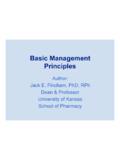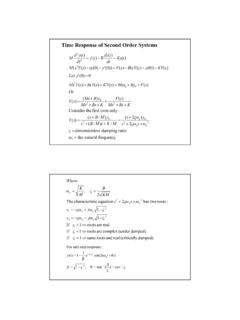Transcription of Basic Management Principles - Mercer University
1 Basic Management PrinciplesAuthor:Jack E. Fincham, PhD, RPhDean & ProfessorUniversity of KansasSchool of PharmacyLearning Objectives Understand Basic Management Principles applying to individuals, small and large organizations Grasp the basics of Management functions Appreciate the ideal characteristics of a good manager See the importance of knowledge of self when viewing Management skills Recognize professional skills required of managersLearning Objectives Appreciate the impact that unresolved issues can have on Management skills Be knowledgeable of the varying available self-development methods Understand strategic planning and its use Understand how project Management tenets can be applied to initiation of new products and services Know how to implement a project and evaluate the processLearning Objectives Understand varying problems from a risk Management standpoint that can impact a pharmacist in a Management position Appreciate varying problem solving techniques and processes; and their applications to pharmacy Management situations Appreciate the origins, key elements and applicability of continuous quality improvement (CQI)
2 Learning Objectives See how the P-D-C-A segments of the CQI process can enable a manager to impact problems and opportunities in pharmacy Know how change impacts varying aspects of a pharmacy View motivation as a crucial skill for a manager in pharmacy settings Appreciate the need to obtain involvement and commitment from others to set in place mechanisms to affect changeKey Management Components Self Controllable surroundings Uncontrollable surroundings The external environmentBasic Management PrinciplesPart 1 Basic Management FunctionsManagement Activities Satisfy varying entities Dealing with emergencies Purchasing Recruitment AccountingManagement Activities Training Planning Negotiating Sales Dealing with regulatory officialsBasic Management Actions Identify what is needed or has to be done Organize resources Monitor performance and task completion Plan ahead for future requirements Deal with any problems that ariseFunctions of Management Actions Target setting Problem solving Leadership Team building Dealing with emergenciesManagement Functions Controlling Directing Organizing Planning StaffingManagement Functions Controlling Establishing standards based upon objectives Measuring and reporting performance Comparing the two Taking corrective/preventive action DirectingManagement Functions Directing Motivation Communication Performance appraisal Discipline Conflict resolutionManagement Functions Organizing Division of labor Delegation of authority Departmentalization Span of control CoordinationManagement Functions Planning Vision Mission Objectives GoalsManagement Functions Staffing Recruiting Selecting Hiring Training RetrainingBasic Management PrinciplesPart 2 Characteristics of a Good ManagerImportance of Knowledge of Self Identity, who are we and what do we aspire to become?
3 New information, what else do we need to know? Relationships, who else needs to be here to work with us?Professional Skills Required of Managers Intellectual skills Technical skills Ethical skills Interactive skills Emotional skillsProfessional Skills Required of Managers Intellectual skills Logical thinking Problem solvingProfessional Skills Required of Managers Technical skills Motor performance at various tasksProfessional Skills Required of Managers Ethical skills Define right from wrongProfessional Skills Required of Managers Interactive skills Communicate intelligently and create an atmosphere that facilitates communicationProfessional Skills Required of Managers Emotional skills Ability to identify and handle one s feelingsMost Threatening Unresolved Issues Poor communication Developing people Empowerment Lack of alignment EntitlementMost Threatening Unresolved Issues Balancing work and personal life Confronting poor performance Coaching senior Management Cross-functional strife Fascination with programsSeeing Decisions Through Identify objectives Analyze relevant factors
4 Consider all alternatives Select the best option Implement the decision Evaluate the resultsManagement Style and Leadership Organization Situation Personal values Personality ChanceSelf-Development Methods Observation Reflection Guided readings Visits / attachmentsSelf-Development Methods Seeking feedback Seeking challenges Presentations Chairing meetings Prepared packagesBasic Management PrinciplesPart 3 Strategic PlanningStrategic Planning Strategic planning must complement strategic thinking and acting. Strategic Planning SWOT Analysis Strengths Weaknesses Opportunities ThreatsStrategic Planning Where are we going? Mission How do we get there? StrategyStrategic Planning What is our blueprint for action? Budgets How do we know if we are on track? ControlStrategic Planning Mission statement Mandates statement S-W-O-T Strategic issues (goals ideal future) Strategies Vision of successStrategic Planning Strategies Practical alternatives Dreams, Visions Barriers Major proposals Major activities Specific stepsStrategic Planning Strategies Staffing plans Financial plans Timelines / responsible personsVision of Success Mission Basic philosophy and core values Goals, if established Basic strategiesVision of Success Performance criteria Important decision rules Ethical standards expected of all employeesEnvironment Stability Complexity Market diversity Hostility CompetitionPlanning Should Lead to Programming Real strategists get their hands dirty digging for ideas, and real strategies are built from the occasional nuggets they uncover.
5 Involve Others Throughout the Organization The cascade of information should not just flow downward Important that it not be a top down only processInvolve Others Throughout the Organization Arm all workers with strategic information allowing to do their job better Provide universal ownership for problems and opportunitiesBasic Management PrinciplesPart 4 Project ManagementFailure of Organizations in Developing Projects Lack of focus and attention Inability to cope with different project characteristics Feelings of being used/exploited Lack of project experienceFailure of Organizations in Projects Inability to cope with different project characteristics New relations with other departments Tighter time and budget pressure Use of different methods and tools Different reporting structure to managementModern Project Management Process Develop ideas and proposals for projects Project approval Project kick-off and start Project monitoring, reporting, and Management Project end or terminationProject Management 10 Commandments Concentrate on interfacing Organize the project team Plan strategically and technically Remember Murphy s Law Identify project stakeholdersProject Management 10 Commandments Be prepared to manage conflict Expect the unexpected Listen to intuition Apply behavioral skills Follow up to take corrective actionDeveloping a Project Management Body of Knowledge Basic project Management functions.
6 Scope Management Quality Management Time Management Cost managementDeveloping a Project Management Body of Knowledge Integrative project Management functions Risk Management Human resources Management Contract / procurement Management Communications managementFour Principles of Quality Management Customer satisfaction The P-D-C-A cycle Plan Do Check ActFour Principles of Quality Management Management by fact Respect for peopleProject Implementation Identify project and non-project work Checklist of issues Project meetings Standardize reporting on the projectBasic Management PrinciplesPart 5 Problem Solving TechniquesProblem Solving Risk assessment and Management Human resources -shortages Equipment -failure Material supply Wars/riotsProblem Solving Risk assessment and Management Government policy -new requirements Finance -cost of borrowing changes Client customer relations -bankruptcy Climate -weatherSix Step Model for Problem Solving Define the problem Identify the criteria Weight the criteria (vary in importance) Generate alternatives Rate each alternative on each criterion Compute the optimal decisionDecision Steps for Problem Analysis Classifying the problem Defining the problem Specifying the answer to the problem Deciding what is right rather than what is acceptableDecision Steps for Problem Analysis Building into the decision the action to carry it out Testing the validity and effectiveness of the decision against the actual course of eventsThe Creative Cycle Germination -> creation Assimilation -> internalization Completion -> finalization, closureBasic Management PrinciplesPart 6 Continuous Quality Improvement (CQI)Origins of TQM, CQI The elements of total quality Management or continuous quality improvement have been attributed to W.
7 Edwards Deming; however, Deming attributes the concept to Walter Shewart at Bell Laboratories. Deming nevertheless applied the Principles to a wide range of Management of CQI Philosophical elements Structural elements Healthcare specific elementsPhilosophical Elements of CQI Strategic focus Mission, values, objectives Customer focus Patient, provider, payer Outcomes of carePhilosophical Elements of CQI Systems focus Data driven process Organizational learningStructural Elements of CQI Process improvement teams Seven tools Parallel organization Top Management commitmentStructural Elements of CQI Statistical analysis Customer satisfaction measures Benchmarking Redesign of processes from scratchStructural Elements of CQI Seven tools Flow charts Cause and effect diagrams Check sheets Histograms Pareto charts Control charts Correlational analysisHealth Care Specific Elements of CQI Epidemiological studies Governance processes Quality assurance, pharmacy and therapeutics committees, peer reviewHealth Care Specific Elements of CQI Risk adjusted outcome measures Cost-effectiveness analysis Quality assurance data and techniques Risk Management dataReasons for Implementing CQI Foundation for organization transformation and renewal Government and patients see lack in quality, cost, and access in healthcare issues Helps to define qualityReasons for Implementing CQI Establishes measures of customer satisfaction Improve upon measures Help for managing costs and increasing profitabilityCQI Perception Shifts Leading vs.
8 Managing Coaching vs. Control Quality -> Quantity Open to change vs. Resistance to change People as a resource vs. People as a commodityCQI Perception Shifts Suspicion vs. Trust Commitment vs. Compliance Customer focus vs. Internal focus Team vs. Individual Prevention vs. Detection7 Deadly Diseases Impeding American Quality Transformation Lack of constancy of purpose Emphasis on short-term profits Personal review system Mobility of Management Running a company on visible figures alone7 Deadly Diseases Impeding American Quality Transformation Excessive medical costs for employee healthcare, which increase the final cost of goods and services Excessive cost of warranty, fueled by lawyers who work on contingency feesCQI ProcessPlanFeedbackDoActCheckCQI and Supervision Training Remove barriers Create pride producing environment Show workers how they fit in the process Stress quality Help improve the workerBasic Management PrinciplesPart 7 Managing ChangeChange and Chance of Success75% of change products do not work!
9 Change Concepts Change is a natural phenomenon Change is continuous and ongoing Survival and growth are dependent upon adaptation to changing environmentChange Concepts Environment can be and is influenced and shaped by the decisions and actions of the organization Learning from experience is essential for adaptation and change Individuals and organizations change in both common and unique directionsChange Affects: Structures Chains of command Responsibility limits Incentive systems Company culture and valuesRequired Skills Knowledge of product, technology, and processes Knowledge of development models Knowledge of organization of development activity Ability to work toward long-term goalsAffecting Change Ability to motivate people Empower Non-threatening Facilitative Obtain involvement Obtain commitment









